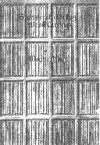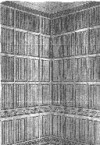


Another chapter of the Charles S. Hall story centers around Hubbard Hill, the home of Elbert Hubbard II and his wife Alta. In this Christmas greeting sent in 1929, we see Hubbard Hill in the making. The Hubbard's beautiful English Tudor-style home was elegantly decorated with Roycroft furnishings. The linen-fold dining room was carved by Charles Hall.

Jeannie Ebert, once associated with the Hubbard Museum, copied several pages from a brochure entitled Seventeenth Century Wood Carvings...in the Modern Home. This publication was from the Ornamental Products Company, in Detroit, Michigan. It described products that looked like carved wood but were, in actuality, made from a form of plastic—probably a mixture of wood fiber and some sort of resin. The "faux-wood" carvings sold by the Ornamantal Products Company were actually the product of molds made from the work done by Charles Hall for the Hubbard home in East Aurora, NY. As stated in the brochure:
Either as a tree in the forest or as lumber in its finished state, wood consists of, or contains, a number of fixed natural elements. Research has demonstrated that through certain processes these elements can be changed from original form into a yielding plastic mass, and then by the application of heat and pressure, made into a multitude of forms adapted to various purposes.Grinling Gibbons an English woodcarver, was born in Rotterdam, The Netherlands. Most noted for his work that he did for Christopher Wren, for royalty and for the ceiling at Petworth (in Sussex), which was done for the duke of Devonshire. He influenced Thomas Chippendale and most certainly Charles S. Hall. This method of creating faux-wood carvings brought architectural carved wood elements within the reach of the "common man" however it certainly diminished the talent, artistry and unique quality of the hand work done by true craftsmen—like Hall. As a handwritten note (written by some unknown person at this time) on the Ornamental Products Company brochure indicates, "This explains why original work is not appreciated." A copy of the Ornamental Products Company Catalog is available. You can almost see Charles Hall carving the shapes shown in the catalog and then the company using them to make moulds for their "faux wood" productsIn our process of manufacture, all details of the original design are reproduced with utmost fidelity; but of equal importance, the texture and absorptive qualities of the natural wood are preserved, consequently our products can be painted, stained or finished as desired. Through the use of this material, exact duplications of rare and beautiful examples of the art of wood carving which reached its height in England, France and Holland during the 17th Century, are brought within the price range of the average home owner, enabling him to staisfy a natural desire for beautiful and destinctive surroundings at an extremely moderate outlay.

At the right
is shown a corner of a room panelled with our M-12 Linen Fold in uniform 11" x 17" size, using M-13 as top moulding and M-14 as an intermediate frieze or band. Here re-created is one of the graceful designs characteristic of the Grinling Gibbons (1648-1721) English period.